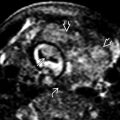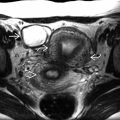KEY FACTS
Terminology
- •
Lethal malformation characterized by attachment of viscera to placenta with short or absent umbilical cord
Imaging
- •
Gross distortion with complete loss of anatomic landmarks
- •
Abnormal fetus inseparable from placenta
- •
Large thoracoabdominal wall defect without covering membrane; often complete evisceration
- •
Absent/very short umbilical cord
- ○
Vessels seen running from placental surface to fetal torso
- ○
- •
Scoliosis, often severe
- •
Limb defects may be present but not major feature as is often seen with amniotic bands
- •
Head usually unaffected
- •
Body stalk anomaly is most likely diagnosis with severe abdominal wall defect (AWD), scoliosis, and “stuck” fetus
Top Differential Diagnoses
- •
In other severe defects, AWD fetus will not be attached to placenta (amniotic bands, pentalogy of Cantrell)
Scanning Tips
- •
Be vigilant at time of nuchal translucency screening
- ○
Early diagnosis allows earlier/safer termination of pregnancy
- ○
- •
Use 3D US to help define anatomic relationships
- •
Color Doppler often useful to clarify confusing anatomy and look for umbilical cord
- ○
Identify fetal vascular landmarks (e.g., iliac bifurcation, renal arteries)
- ○
- •
In fetus with large AWD, look for free-floating loops of cord
- ○
Absent or short cord = body stalk anomaly
- ○
Normal cord makes amniotic bands more likely
- –
Roll patient, look for delicate bands as fetus “floats” away from placenta
- –
- ○
 attached to placenta
attached to placenta  . Scoliosis results from fetal tethering. The upper part of the fetus is inside the amniotic cavity
. Scoliosis results from fetal tethering. The upper part of the fetus is inside the amniotic cavity  while lower parts are in the extraembryonic coelomic cavity. There is no normal umbilical cord.
while lower parts are in the extraembryonic coelomic cavity. There is no normal umbilical cord.
 is in amniotic cavity. Viscera
is in amniotic cavity. Viscera  are in extraembryonic coelomic space anchoring fetus to the placenta
are in extraembryonic coelomic space anchoring fetus to the placenta  , causing scoliosis
, causing scoliosis  . The amnion
. The amnion  (not a band) is visible at the edges of the AWD.
(not a band) is visible at the edges of the AWD.
 with the spine bent into a U shape and evisceration of the liver
with the spine bent into a U shape and evisceration of the liver  and bowel
and bowel  , which are adherent to the placenta
, which are adherent to the placenta  .
.
Stay updated, free articles. Join our Telegram channel

Full access? Get Clinical Tree








